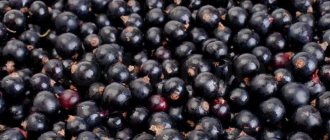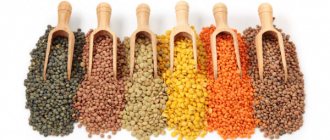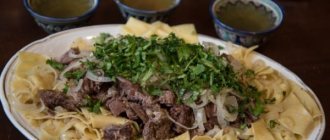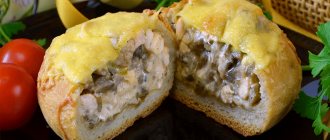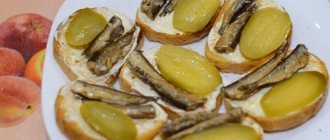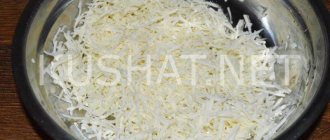Armenian cuisine is considered one of the oldest in the world. Great baked goods, delicious meat dishes, skillfully prepared vegetables, incredible desserts - people in this country really know a lot about food. We'll tell you what you need to try first in Armenia. We’ll advise you on what products you should bring home to replicate the options you like in your kitchen. Descriptions of traditional Armenian dishes with photographs will help you not to confuse anything and find all the most delicious things.
Armenian wines and cognacs are so good that we have dedicated a separate article to them.
Khorovats
The most popular dish of Armenian cuisine that every tourist needs to try. Khorovats is a kebab for which Armenia is famous throughout the world. The dish is prepared from large pieces of pork or lamb. The meat is marinated in cognac or wine. Despite its impressive size, the Armenian kebab turns out to be evenly fried: an appetizing crispy crust on the outside, juicy flesh on the inside. It is usually served with vegetables baked on coals. There are two types of khorovats worth trying in Armenia:
- Kars - large pieces of meat are fried on skewers and exclusively on coals.
- Khazani is a kebab made from selected steaks, fried in a frying pan until golden brown.
In the bazaars of Yerevan you can buy good black pepper, without which it is impossible to cook good kebab. Bring the spice home - it will come in handy.
TOP 10 Lenten dishes of Armenian cuisine
The Great Lent of the Armenian Apostolic Church in 2020 begins on March 4 and will last until April 20. During Lent, you can cook and eat only products of plant origin. You should not eat dairy, meat products, eggs, or ghee.
By the way, it is common to mistakenly associate Armenian cuisine with meat dishes. In fact, this is not true at all. Most of the Armenian cuisine consists of lenten dishes, let's not forget that our ancestors observed all fasts, and they made up most of the year, in addition, they ate a balanced diet in accordance with the seasons: in winter, hearty soups from legumes, in summer, a lot of greens and vegetables. So, what are the most popular and favorite Lenten dishes of Armenian cuisine in my opinion?
1. Aveluk soup. There are many variations of the soup, but the main ingredient is aveluk. This is the basis. Further, depending on the region and preferences, aveluk soup is mainly seasoned with either lentils or bulgur , and it is always seasoned with garlic. There is an option with plum pastille. Aveluk soups are very nutritious, tasty and rich in vitamins.
Aveluk soup with lentils
Read also: “Not all meat or 10 vegetarian dishes worth trying in Armenia”
2. Aveluk salad. Unlike soup, salad is served as an appetizer, as an addition to the first course. A salad of boiled and fried aveluk with onions in vegetable oil is served generously sprinkled with walnuts and pomegranate seeds. The slightly bitter unusual taste of aveluk, seasoned with nuts, will be appreciated by true gourmets.
Aveluk salad.
3. Zhengyalov hats is the hallmark of Artsakh cuisine, but Syunik also has its own recipe for Zhengyalov hats. A thin flatbread made from flour and water dough, stuffed with finely chopped herbs from 7 to 33 types, is baked on a hot iron sheet. You can try the real zhengyalov hats in early spring, when there is an abundance of greens.
Zhengyalov Khats is a signature dish of Artsakh.
4. Pasuts (lenten) tolma.
The most famous recipe for this dolma is boiled beans, lentils, chickpeas, and dzavar wrapped in salted cabbage leaves. All cereals and legumes are seasoned with fried onions and dried herbs. It is dried herbs, especially citron (savory), that give an amazing aroma. This tolma is not small in size, one piece is enough for lunch. Very tasty when served cold.
All cereals and legumes are seasoned with fried onions and dried herbs. It is dried herbs, especially citron (savory), that give an amazing aroma. This tolma is not small in size, one piece is enough for lunch. Very tasty when served cold.
As options for Lenten dolma, there is tolma with rice (essentially tolma), there is a recipe with lentil filling, there is pasuts tolma with dzavar or bulgur.
Pasuts (fast) tolma
5. Cereal soups. More than a dozen variations of bean soups: lobapur, lobushorva, lobahashu , pochapur, lobespas, etc. Soups from a set of cereals: beans and dzavara, beans and achara, lentils. An excellent alternative to meat, providing energy for the whole day.
Lobahasha
6. Arishta with mushrooms. Not just a Lenten dish, but a delicacy Arishta is homemade, pre-fried noodles. Arishta is seasoned with a large amount of mushrooms fried with onions in vegetable oil. An incredibly tasty dish with a light nutty taste.
Not just a Lenten dish, but a delicacy Arishta is homemade, pre-fried noodles. Arishta is seasoned with a large amount of mushrooms fried with onions in vegetable oil. An incredibly tasty dish with a light nutty taste.
Arishta with mushrooms
7. Spelled (achar) with mushrooms. Today, spelled is becoming a fashionable cereal; it is sold in all organic and health food stores. It has been present in Armenian cuisine since time immemorial. Mushrooms fried with plenty of onions are added to the spelled, mixed and simmered for a couple of minutes. Don’t forget to serve homemade pickles with spelled mushrooms; they go amazingly together.
Spelled (achar) with mushrooms
8. Krchik . Hearty soup made from salted cabbage and crushed dzavar. This lightly sour soup is wonderful not only on fasting days, but also on regular fasting days. Once the most common soup, today krchik is included in the menu of the best Armenian restaurants.
Krchik
9. Green soups. Here we have more than one or two recipes. The most popular soups are made from nettle and mallow (pipertka). Spring-like light, low-calorie, but very healthy, in other words, a soup of vitamins 
Nettle soup
10. Bean paste. Regular boiled beans that turn into a delicious snack. Just grind the beans into a puree, add nuts, a little garlic, salt and pepper. You can serve it as a roll, or you can make balls, roll in finely chopped nuts and garnish with pomegranate seeds. In any case, delicious.
Bean pate
10 dishes, but there are still so many dishes left, so tasty and so loved, this is the sweet chamcharak soup, and Lenten pastries with dried fruits, and stewed greens, and the magical khapama-pumpkin stuffed with rice with honey and dried fruits, but more on that next time .
© Aregnaz Margaryan
“Armenian cuisine: today, tomorrow, yesterday” on Facebook “Armenian cuisine: today, tomorrow, yesterday” on Instagram
Article Rating
( 1 ratings, average: 5.00 out of 5)
Kufta
Of course, this dish can be tried not only in Armenia. However, kofta meatballs are prepared in a special way in this country. They use exclusively selected beef. The meat is twisted into homogeneous minced meat, then onions are added to it, and sometimes a little wine. In Armenia, kofta is usually served with melted butter and hot tsitsak pepper - try the dish in this form without a side dish to reveal the true taste of the meat.
Bring a few pods of green tsitsak pepper from Armenia. It is useful not only for serving kofta.
National cuisine of Armenia
Armenian cuisine is the national cuisine of the Armenian people. It is as ancient as the land on which it was formed. The tradition and continuity of Armenian cuisine are manifested in various ways - for example, in the use of ancient kitchen utensils and in the technology of cooking.
What is the peculiarity of Armenian cuisine?! The uniqueness lies in the fact that a fairly large number of different spices are used in the preparation of almost any dish. In addition, the recipes of Armenian cuisine cannot be called simple. All dishes are quite complex to prepare; these processes are intricate and strictly require a certain sequence of actions.
Meat dishes occupy a special place in Armenian cuisine. The famous meat dish is shashlik (in Armenian “khorovats”). Before frying, the meat is marinated - each in its own sauce: cognac, wine, vinegar, so that the pieces are fried at the same time. It is the addition of these sauces and spices that gives Armenian kebab its unique taste.
Dolma – delicious Armenian cabbage rolls made from grape leaves. Usually it is traditionally served with matsun and crushed garlic. Walnut-mushroom and cherry sauces are also often used as seasonings for dolma. To prepare dolma, three types of meat are used: pork, beef and some lamb. Spicy herbs such as basil, oregano (oregano), and tarragon are also required.
Arisa or harissa is one of the most beloved dishes of the Armenian people, and is also a national dish. It is made from wheat and chicken, lamb or beef. They are cooked in water and mixed until they turn into a porridge-like substance. Harisa is associated with events related to the defense of Armenian villagers near Mount Musa Dag during the Armenian genocide in Turkey in 1915. The preparation of harissa during the siege, in addition to its practical meaning, encouraged the defenders: “Like everything ancient that has passed from the memory of generations, so this food and its preparation are fanned with a solemn and religious spirit. The mere mention of the Harissa holiday made the gloomy people perk up.”
Kufta is the pride of Armenian cuisine. No one knows exactly how old this dish is. These are tender meat balls made from meat beaten in a special way and boiled in broth, dissolving in the mouth and having an unearthly taste. When you are in Armenia, don’t miss the chance to try this dish.
The most famous Armenian soup is khash (from “khashel” - “to cook”). In ancient times, this dish was considered ritual and was cooked after sacrificing cattle to the gods. It was also called the poor man's dish. After cutting up the carcass, the legs and entrails of the animal were given to the poor people, who cooked a rich soup from the second-class meat. Therefore, the traditional classic Armenian khash is prepared from beef legs, as well as tripe (the largest part of the stomach of ruminants) and garlic. The soup is served early in the morning before breakfast or for breakfast.
Traditional Armenian bread - lavash - is a thin unleavened bread, which is still baked using ancient technology in clay tandoors, in which women work wonders - every day they work for hours to create aromatic, delicious, crispy or, conversely, soft lavash. Of course, we cannot leave aside the fruits and vegetables that grow in Armenia. Even the Armenian flag speaks of the fact that fruits exist and grow in Armenia. After all, the bottom orange stripe is the color of apricot!
The rivers of Lake Armenia are rich in fish, which is fully present on the Armenian table. The main types of fish are whitefish and trout , which are grown and caught in Lake Sevan (Sevan trout is called “ishkhan”).
The most famous flour sweets are kyata and nazuk - unique multi-layer pies with filling. Each layer is soaked in melted butter and sugar, which is why kyata and nazuk have such melting dough and the most delicate taste.
The culture of consuming traditional drinks is highly valued in Armenia. Among the Armenian non-alcoholic drinks, the most famous are the local mineral waters of Jermuk, as well as matsun, an analogue of kefir. After a hearty meal, Armenians prefer to drink “surch”, that is, coffee.
It is impossible to talk about Armenia without recalling the famous Armenian cognac . Nowadays, six varieties of grapes are grown specifically for the production of cognac in Armenia.
Thanks to climatic conditions conducive to viticulture, unique dessert and “sherry” wines . Armenian grapes contain a high amount of sugar, resulting in a stronger wine with a high alcohol content.
Armenian cuisine is one of the most impressive components of Armenian culture. The cuisine reflects the history and customs of the Armenian people and also includes elements created under the influence of various historical events and periods.
Tolma
Or dolma - whatever. Azerbaijan and Armenia constantly argue about the identity of this dish. No one knows where the original recipe was invented. However, this does not matter, because both nations prepare amazing dolma, which tourists should definitely try. Ruddy grape leaves stuffed with rice, chopped beef and herbs. A very filling, appetizing, truly delicious dish. Vegetarians in Armenia are advised to try pasuts tolma – skillfully prepared vegetables stuffed with a mixture of beans and grains.
Bring a mixture of spices for dolma from Armenia. Market traders will definitely help you choose the “right” seasonings.
Harisa
Harisa (or harisa) is a very hearty Armenian dish. This is a cross between puree soup and porridge. Harissa is prepared from boiled wheat (dzavar grains) with chicken. Before serving, a generous knob of butter is usually added to the dish. It sounds too simple, but this is the first thing you need to eat in Armenia in winter. Harissa seems to warm you from the inside, and its delicate taste is very pleasant.
In Armenia you can buy some dzavar cereal. She's very helpful. You can use it to prepare not only harissa, but also regular whole grain porridges.
Fermented milk products[ | ]
Main articles: Matsun
,
Cheese
and
Paneer (cheese)
Installation for making butter.
Cattle breeding also became a source of a variety of dairy products.
Zhazhik cottage cheese and also dry buttermilk - chortan are made from whey from matsun (matsoni) or buttermilk. Armenian condensed milk - serots - also has ancient roots. All these dairy products belong to frequently consumed products along with bread.
Cheeses occupy a large place in the diet. White cheese is widespread in Armenia. Also popular are wineskin cheese (motal), braided cheeses (chechil, hyusats paneer), mold cheeses (kanach paneer, mklats paneer).
Spas (soup) or tanapura
(from Armenian
tan
- diluted matsun,
apur
- soup) - a dish
of Armenian cuisine
, fermented milk-based soup,
traditionally it is wheat porridge made from a special type of whole grain cereal called dzavar
.
Spas / Tanapur
This fermented milk soup is worth trying twice in Armenia: hot in winter, cold in summer. Imagine dzvar cereals cooked and then dried to a slight crunch. Add to it matsoni (this is a fermented milk drink, reminiscent of our yogurt), spices, and eggs. The latter are poured raw and then boiled as part of the soup - it’s tastier. In summer, the soup is usually diluted with tan and cooled, and in winter it is served thicker.
Dried basil, cilantro, mint - these spices can be bought at the bazaars of Yerevan to bring home. With these you will prepare tanapura in your kitchen.
Hash
A popular dish of Caucasian and Transcaucasian cuisine in Armenia is prepared a little differently. It is considered national, so it’s definitely worth trying. Khash is a soup made from beef legs, head and tripe. It doesn't sound too appetizing, but it actually turns out delicious. At least meat lovers who decide to try Armenian khash soup are satisfied. The meat and bones are thoroughly cleaned and then boiled for 6-8 hours. Only broth is used for food. The bravest drink it in the morning before breakfast. For lunch in Armenia, khash is served with pieces of meat separated from the bones. Radishes, herbs, and thin dried pita bread are required. In Armenia it is not customary to eat khash with cognac (only vodka).
Traditional cuisine recipes in Armenia
If you prefer a pronounced taste of dishes, then you will like national dishes. Local cuisine is considered quite spicy and salty. People here do not hesitate to use salt, as they believe that it makes dishes especially delicious, especially in combination with spices. Let's touch on the main areas of local gastronomy.
Armenian appetizers and first courses
They are very passionate about preparing snacks here. Basturma is one of its famous types; it is a dried beef tenderloin. There is even a legend about how it was invented. According to legend, Genghis Khan's warriors were the first to learn how to cook it. When going on a raid, they hid pieces of meat under horse saddles. On the way, the meat went through a period of pressing, and was also soaked in horse sweat. The result was dried and slightly salty meat that could be stored for a very long time.
Appetizers also include the famous beef sausages, which have an incredible taste. We can’t help but mention lula kebab and crayfish tails. You can find a variety of salads based on vegetables. Dishes made from Armenian lavash are very popular. At the same time, lavash itself is an important component of national cuisine. It can be used both as bread and to complement soups and main courses.
Here is the recipe for the famous Armenian lavash, which is considered classic:
For 3 cups of flour, take 1 cup of hot water and a teaspoon of salt. The dough must be thoroughly kneaded to saturate it with air. After it is kneaded, it should be left for half an hour, covered with a napkin, and then divided into equal parts and rolled out into thin cakes.
Fry in a hot dry frying pan without using oil. It is important not to overcook the tortillas so that they are moderately soft. After the pita bread is removed from the pan, you need to sprinkle it with water and place it under a napkin.
This homemade recipe is very simple. It does not require the use of yeast, although there are yeast methods. In 2014, Armenian lavash was included in the UNESCO list of intangible cultural heritage.
Armenian soups are always excellent, they are particularly rich. Thus, khash soup has been known since the 12th century. This dish takes 24 hours to prepare. Many soups add a lot of vegetables and spices. At the same time, soups always look thick and very high in calories, since most first courses are prepared from meat with the addition of cereals. If you want to try something light, an experienced chef will recommend Chulumbur Singapore. This is a rice and onion soup with beaten eggs.
Second Armenian dishes
When talking about second courses, people first of all remember the famous tolma - a kind of cabbage rolls in which grape leaves are used instead of cabbage leaves. The dish, prepared in the traditional way, tastes amazing. Many will be interested in the recipe for Armenian dolma, which can be prepared at home.
The preparation involves lamb and beef in equal parts, grape leaves, onions, tomatoes, rice, and spices. The sauce requires meat broth, tomato paste, vegetable oil and matsun (fermented milk product).
The minced meat is prepared according to the same procedure as for cabbage rolls - half-cooked rice, minced meat, chopped tomatoes, onions, and garlic are mixed. Washed grape leaves need to be scalded with boiling water, and it is better to take young leaves so that they are not too hard. The minced meat is placed in the middle of the sheet and wrapped in a tube. After that, all the tubes are placed in a pan and filled with sauce. The dish is stewed for an hour and served hot.
It is impossible to prepare national dishes of Armenia without barbecue. This is also a traditional dish. It's called Khorovats. It is prepared in different ways, so there are at least 20 kebab recipes here.
Usually the meat is marinated and then grilled. But, there is a variation of its preparation, when such fried meat is additionally stewed in a cauldron. Wine, cognac, and lemon juice are used for the marinade. Of course, barbecue in Armenian style is impossible without a large amount of spices and herbs. Vegetables are used as a side dish - tomatoes and eggplants with bell peppers and onions.
Finally, it is worth mentioning such a dish as lamajo, which is a type of pizza. Homemade recipes are often similar to Mediterranean cuisine, although they have their own unique flavor.
For those who like pizza, we offer a delicious lamajo recipe. To prepare it you will need lamb, fat tail fat, unleavened dough, tomato paste, onion, salt and seasonings. Minced meat is prepared from lard and lamb, to which spices and onions are added, as well as tomato paste. After this, the minced meat should stand for a quarter of an hour and marinate. Then the dough is rolled out into small thin cakes. Minced meat is spread on each of them and placed in the oven until cooked.
Nazuk
Appetizing yeast buns with delicious filling - this Armenian pastry is popular with many tourists. Fragrant rolls with a golden brown crust smell of vanilla. Inside are crushed nuts with sugar. Nazuk is considered a type of Armenian gata. That is, a subtype of sweet bread popular in Armenia. However, classic gata, as a rule, does not have filling. It’s more interesting to try nazuk – it’s truly a unique pastry.
You can easily bring these buns home from Armenia as a gift to your loved ones. Buy before departure and take it in your hand luggage.
Hapama
A sweet dish that is very popular in Armenia. Previously, it was prepared only on holidays, but today it can be found at any time of the year. Khapama is an Armenian dessert made from baked pumpkin stuffed with rice, dried fruits, nuts, apples, plums, dates, and most importantly, spices. The natural sweetness of the dish is complemented by honey. Pumpkin is usually served with melted butter. This dish in Armenia is worth trying for vegetarians and all those with a sweet tooth. Spicy, healthy, tasty. Hapama is especially good in the fall with aromatic tea.
Bring home Armenian dried fruits. They are natural and not processed in any way. In the markets of Yerevan you can buy dried apricots, prunes, raisins, figs or something else - all at reasonable prices. To make khapama, you should also buy almonds or other nuts.
Ten traditional dishes that Armenians love to eat in winter
YEREVAN, November 21 – News-Armenia.
Armenian cuisine is one of the oldest in the world.
Its component is hearty winter dishes that can warm you up in frosty weather and give you strength and energy until the arrival of spring. The end of winter often coincides with the period of Lent, so many Armenian winter dishes are purely vegetarian. On the eve of the winter season, we decided to present you the most popular dishes that Armenians prefer to eat during the cold season. 10) Aveluk soup
Aveluk or horse sorrel is a wild herb that Armenians use to make soups and salads. Armenians call it “banjar”. It has a specific bitter taste and is also widely used in folk medicine to treat diseases of the gastrointestinal tract.
Photo from blog Aregnaz Baghdasaryan
Aveluk is collected in the spring and stored for the winter, braided. Store all winter in a linen bag.
Recipe:
aveluk (dried) - 75g peas - 20g potatoes - 100g onions - 25g vegetable oil - 20g wheat flour - 3g salt - to taste.
Rinse dried aveluk in warm water, chop coarsely, place in a pan with salted water and cook until half cooked. Add pre-cooked peas, diced potatoes, finely chopped onions fried with flour and continue cooking until tender. Add crushed garlic if desired.
9) Pasuts-tolma or Lenten tolma.
Pasuts tolma (Lenten tolma) is a traditional dish of Armenian cuisine. The word “Pasuts” comes from the word “Pas”, which means “Lent” in Armenian.
Photo from the website Multivarene
This dish is very practical, because it is stored in the refrigerator for quite a long time and only becomes even tastier! Therefore, on the one hand, it can be prepared in advance, and on the other, used over several holidays or Lent...
Recipe:
pickled thin cabbage leaves (you can use fresh ones - it doesn’t matter) 1 tbsp dry chickpeas 1 tbsp. split peas 1 tbsp. lentils 1 tbsp. red beans 1 tbsp wheat grain - blgura onion - tomato paste salt, pepper, spices - sour plums (optional, but desirable)
Pre-soak sauerkraut leaves in cold water for 2 hours. Soak all grains except blgur overnight. The next day, cook until done. Peel the chickpeas from the film. Mix all. Add onion, finely chopped and fried with tomato paste, salt, spices. Mix well again. Wrap the filling in leaves; the dolma should be large in size. Place in a saucepan, sprinkle with plums. Pour in water diluted with tomato paste. Cover with an inverted plate and boil until tender.
 Lobi (bean soup)
Lobi (bean soup)
Beans are no less popular in Armenian cuisine than meat. Not only due to its taste and satiety, but also due to its extreme usefulness. Therefore, Armenians have given a special place to beans in their cuisine.
Photo from Gratitude website
Recipe:
red beans – 2 tbsp; water – 1.5 l; onions – 2 pcs.; walnuts (peeled) – 0.5 tbsp.; a little flour and melted butter; greens (cilantro); salt, spices (red pepper).
Pour the washed beans with cold water for 6 hours, then rinse thoroughly. Fill with water again and bring to a boil over medium heat and skim off the foam. Then reduce the heat and cook until done. Thoroughly grind the finished beans through a sieve and dilute them with bean broth until thick. Add finely chopped and fried onions, crushed nuts, flour diluted with bean broth, salt, pepper and cilantro to the bean mass. Mix everything, dilute with the remaining broth, bring to a boil - the lobi is ready!
7) Krchik
Krchik is a distant relative of Russian cabbage soup, as it is made from sauerkraut. However, it contains a lot of unexpected components for cabbage soup. For example, wheat cereal and tomato paste.
Photo from the Gastronom website
Recipe:
wheat grits - 1/2 cup sauerkraut - 500g onions - 2 pcs. tomato paste - to taste melted butter - for frying potatoes - 500g salt, pepper - to taste parsley (greens) - to taste.
Finely chop the onion and fry in oil. Then add washed, drained and finely chopped sauerkraut and simmer it all in oil in a deep frying pan until tender, periodically adding a little water to the pan. Then add tomato paste to the stewed vegetables, mix well and simmer again for another 5-7 minutes. Boil potatoes (peeled and chopped, of course) and small grains separately, and then combine them with the broths with stewed vegetables, after which the soup should be allowed to boil for 10-15 minutes. Krchik is served sprinkled with red sweet pepper and parsley. 6) Bozbash
Bozbash is a meat soup made from fatty lamb brisket with a variety of vegetables and fruits, slightly acidified. Along with the simple version, the Armenian bozbash has several varieties - both regional (Yerevan, Etchmiadzin, Sisian, Shusha old and Shusha new) and seasonal (summer and winter).
These varieties differ in the composition of the so-called additional vegetables and fruits, while the amount of meat and liquid (water), main vegetables and a set of herbs remain unchanged in all cases. All types of bozbash are prepared according to the same technological scheme.
Recipe:
In any bozbash, for every 500 g of lamb, 2 liters of water and 25-50 g of ghee or butter are used for frying meat and vegetables. Thus, the concentration of broth and the amount of meat per serving are always the same. However, lamb brisket is cut into pieces of different sizes for different types of bozbash: the size of half a matchbox (Echmiadzin, Shusha, summer, winter), the size of a matchbox (Sisian, Shusha old), the size of two boxes (Yerevan). Accordingly, per serving in different bozbashi there are then four, two or one piece of meat, each with a rib.
Pour cold water over the meat and cook the broth, covered, over low heat for 1-1.5 hours, then remove the half-cooked meat from the broth. Fry it in melted butter or butter in a cauldron or thick-bottomed saucepan with or without vegetables; or scald and rinse with boiling water - depending on the type of bozbash. Pour the scalded and washed meat with strained broth and bring to readiness for different times - depending on the size of the pieces of meat - along with fried and additionally added vegetables and fruits, as well as a set of spices.
At the end of cooking, all bozbashi are acidified with either 1 tbsp. a spoonful of wine vinegar (plain, winter, Yerevan), or a thinner natural acidifier - lemon juice or 50-100 g of pomegranate juice (summer, Sisian, Shusha). Bozbash is salted 10 minutes before it is fully cooked, before adding greens and acidifying.
5) Achar pilaf with mushrooms
This is a popular dish in Armenia. It is prepared with ghee, and many housewives make very tasty ghee themselves. But in order for pilaf to fully meet all the requirements of the Lenten table, it can also be made with vegetable oil.
Recipe:
fine sea salt - to taste fresh champignons - 250 g soy sauce - 2 tbsp. l. large onion – 1 pc. black pepper - to taste achar - 1 cup refined vegetable oil - 4 tbsp. l.
Sort and rinse the achar. Cut the onion into thin half rings, heat the vegetable oil in a saucepan (preferably with a thick bottom), fry the onion until transparent. Cut the champignons into thin slices, add to the onion and continue frying for 5 minutes. Then pour in soy sauce, stir, salt and pepper, cook for another 2 minutes. Add achar, mix gently, heat for 2 minutes and pour 2 cups of boiling water. Reduce heat, cover and simmer until tender, 20 minutes. Serve hot.
4) Conchol
Konchol is a traditional Armenian bread soup with egg and herbs.
Recipe:
Chop the onion and fry in vegetable oil, adding pepper, boiled water, beaten egg, herbs (dill, thyme, coriander). Remove from heat, add dried bread. At the end, season the matsoni with garlic.
3) Hapama
From time immemorial, the dish has been symbolically served at Armenian weddings, so that the life of the newlyweds would be sweet, rich and bright, like pilaf baked in pumpkin. Hapama is a pumpkin stuffed with rice and dried fruits, poured with honey and oil, and finished in the oven.
Very nutritious, healthy and tasty. At Easter, this dish is served with the usual fish and decorated eggs, and in late autumn and winter it goes with pumpkin.
Recipe:
1 medium pumpkin 1 cup rice 1 cup assorted dried fruits 1 cup nuts 1 small cup oil (or 2 tablespoons butter) cinnamon Bahar salt
Cut out the top of the pumpkin as this will be the lid for it. Then peel the pumpkin kernels. Chop dried fruits and nuts into heated oil. Add rice, honey and chop fruit and nuts to fill half of the squash. Add water to cover rice. Cover the pumpkin with its top and cook in the oven until the rice absorbs water. The pumpkin is ready.
2) Arisa
Arisa may not look very "presentable" but it is a very tasty dish that is perfect for cold winter days.
Arisa is one of the favorite dishes of Armenian cuisine. This is, in fact, wheat porridge with chicken, boiled to a viscous, homogeneous state. When preparing arisa, they certainly invite relatives and friends to share a meal of enjoying this delicious dish with them.
Recipe:
chicken 1200g round grain wheat (dzavar) 400g water 4 l salt for serving butter
Rinse the cereal and soak in cold water for 1 hour. Chop the chicken into pieces (I don’t do this), put it in a saucepan with a thick bottom, add the cereal, add water and cook over medium heat. Let it boil, skim off the foam. Reduce heat to low and forget about it for 1.5 hours.
Then remove the chicken and separate the meat from the bones (I do this right in the pan using two forks). Put the meat back in the pan and beat it with a large wooden spoon. Continue cooking until everything turns into a homogeneous, viscous mass (all this takes another 30-40 minutes).
At the end, add salt to taste, stir and turn off. Leave the porridge to “rest” for 15-20 minutes and serve in a deep plate with a piece of butter.
1) Khash
The famous Armenian khash is a special dish. A huge number of wonderful qualities are attributed to him, the most important of which is the so-called sobering effect. They say that Armenian khash is so good that even a dead drunk person, after eating a bowl of this soup, becomes sober, healthy and cheerful. And that is why on the third day of an Armenian wedding, all guests are treated to hash.
Recipe:
beef legs - 1.5 kg. tripe - 0.5 kg. garlic - 3 heads radish - 1 pc.
To begin with, the beef legs should be properly singed, scraped, and washed thoroughly. Then cut into pieces and soak for a day in cold running water. You can simply fill it with cold water, but then it needs to be changed every 2-3 hours. After a day, we wash the legs again, put them in a narrow saucepan and fill them with water so that its level is 15-20 cm above the level of the product. We put the pan on the fire. Cook over low heat for 7-8 hours at a very low simmer, without salt, half-covered with a lid (add cold water a couple of times and remove any remaining foam from the sides of the pan with a paper towel).
While the legs are cooking, let's take on the tripe. It needs to be cleaned and washed. Place the tripe in a saucepan, add cold water and cook until the specific smell disappears. To do this, bring the water to a boil, remove the foam and boil it for 15 minutes. Then drain the water, rinse the tripe, add water again and cook until the specific reserve disappears. Then we pour out this broth, wash the tripe, cut it and put it in the pan where the legs are cooked. Khash is considered ready when the meat easily begins to separate from the bones.
In 5 minutes, you need to pour the skimmed fat into the soup and serve it very hot.
Before pouring the hot khash into bowls, you need to prepare the garlic dressing. To do this, peel the garlic, crush it in a mortar with coarse salt, and pour in a ladle of broth. Peel the radish and cut into thin slices. Pour the soup into bowls, serve with garlic dressing, radish and lavash leaves.
Bon appetit! -0-
Alani
A very tasty natural Armenian sweet that should please those with a sweet tooth (in the photo - on the left and in the middle between the churchkhela). Alani is made from sun-dried peaches. The pit is removed and the fruit is stuffed with an amazing mixture of walnuts ground with sugar, cinnamon and cardamom. The aroma of this Armenian dessert cannot even be described in words - be sure to try it. This unique sweet is almost impossible to find outside of Armenia, so don’t give it up.
Yerevan markets traditionally have a large selection of alani. Sometimes this sweet is made with figs or apricots instead of peaches. All options are worth bringing from Armenia as a gift to your loved ones.
Ashure
A popular Armenian dessert that is traditionally prepared on Christmas and New Year's Eve. It always decorates the holiday table. You can try it in Armenia at other times - the locals almost always prepare it for tourists. This is a very aromatic sweet dish made from grains with dried fruits, nuts, zest and natural sweeteners. Cardamom, nutmeg, pepper, cloves, and cinnamon give it a special spice. Armenian sweetness has a very interesting taste, be sure to try it.
Bring home spices for sweet dishes. In the markets of Armenia they are natural, really high quality, and inexpensive.
Notes[ | ]
- V.V.
Pokhlebkin. “Armenian cuisine” // “National cuisines of the peoples of the world”. - M.: Tsentrpoligraf, 2009. - P. 169. - 640 p. — (Classics of culinary art). — 4,000 copies. — ISBN 978—5—9524—4050—0. - S.P.Zelinsky /Erivan/Collection of materials for describing the areas and tribes of the Caucasus. Issue 1. 1881 - p.28
- V.V. Pokhlebkin / Great Encyclopedia of Culinary Art / Tsentrpoligraf, 2005
Purely vegetable dishes of Armenian cuisine are prepared mainly from pumpkin, eggplant and legumes (peas, lentils, beans). At the same time, such dishes include several vegetable and fruit components, as well as grains (rice, wheat). As a rule, vegetable dishes rarely have national names, with the exception of vegetable tolma, aylazan (eggplant-based dish) and mshoshi (bean puree). Many of the vegetable dishes do not have national specifics. Therefore, below are only those vegetable dishes that are distinguished by a special composition, combination of products or technology typical of Armenian cuisine. It should be noted that if the technology of meat dishes in Armenian cuisine is complicated, then the technology of vegetable dishes is simpler than in Georgian cuisine.
- V.V. Pokhlebkin / Great Encyclopedia of Culinary Art / Tsentrpoligraf, 2005
Pumpkin dishes Pumpkin is quite widely used as food in Armenia: in the form of porridge, fried, baked, and stuffed. The most specific are boiled pumpkin with lentils, pumpkin casseroles with spices and stuffed pumpkin with rice-fruit or dogwood-nut mince.
- V.V. Pokhlebkin / Great Encyclopedia of Culinary Art / Tsentrpoligraf, 2005
Eggplant dishes Eggplants are used in Armenian cuisine as often as in Georgian, and some methods of pre-processing eggplants are the same (for example, squeezing, although it is not used as often in Armenian cuisine). However, while Georgian eggplant dishes feature separately cooked eggplants with sauce or other seasonings, in Armenian cuisine the eggplants are cooked along with other vegetables in one pan and are usually baked in the oven or tonir. An example is the national Armenian eggplant dish, aylazan, where eggplant is only one of many components. In Armenian cuisine, eggplants are stuffed with peas and cheese or combined with pumpkin and green beans in a 2:1:1 ratio. Matsun with crushed garlic is used as a mandatory gravy for all eggplant and most vegetable dishes.
- P. Ogorodnikov
. “On the way to Persia and its Caspian provinces.” Chapter VIII. St. Petersburg 1878.
Thematic tours
National cuisine is an important part of Armenian culture, so without getting to know it, immersion in the traditions of Armenia will be incomplete. You can arrange independent tastings or get a taste of the local flavor during gastronomic tours. We have selected the most interesting options for excursions in Yerevan in Russian.
Master class on sweets
A popular excursion with excellent reviews - a budget option for 1 person or a couple. The master class will be given by a professional pastry chef in the very center of Yerevan. Baklava, gata, nazuki... You will learn the secrets of their “correct” preparation. And at the same time you will hear about the eating habits of Armenians and traditional national cuisine. It will be very interesting, sincere, fun!
Excursion to southern Armenia
From Yerevan you will go to the most colorful part of the country. The legendary Khor Virap, one of the most beautiful waterfalls in Armenia, the Noravank monastery and impressive cliffs are just part of the fascinating route. The icing on the cake is a master class on how to prepare authentic Armenian kebab or other national dishes.
Gastronomic tour in Yerevan
Excursion in Yerevan in Russian with brilliant reviews (read it - tourists are delighted!). First, you will visit the best market in Yerevan, where excellent products await you. Having chosen everything you need, you will go to visit an Armenian family. Along the way you can stop for some great wine. During the excursion you will learn how to cook the main national dishes and just have a good time.
Shashlik and the history of Yerevan
The highest mountain in Armenia, medieval monasteries, impressive nature - the tour from Yerevan to the north-west of the country will be eventful. On the way there is a unique lake, which is shrouded in snow all year round. As well as many other man-made and natural attractions. After a busy day, a master class on preparing famous Armenian dishes awaits you. Of course, it won’t be possible without a traditional dinner.
Cognac and sweets
This is a great chance to explore and try the best Armenian cognac: or “Ararat” - the choice is yours. During the excursion you will also have the chance to take a master class on preparing Armenian dishes according to ancient recipes. Kufta, suchukh, alcoholic liqueurs - it will be interesting. That's not all: during the gastronomic tour you will visit the legendary chocolate factory and learn a lot about the history of Yerevan and the culture of the country.
Before traveling to Armenia, be sure to read our guide to smart shopping in Yerevan, Gyumri, Vanadzor and other cities in this country. Souvenirs, jewelry, delicacies and much more - we've collected the best shopping ideas in one place.
>>> Useful services for travelers (gift inside!) <<


